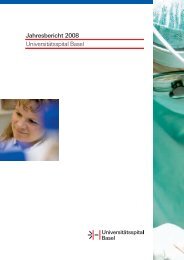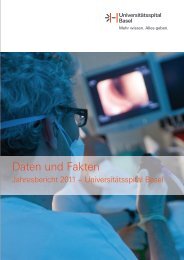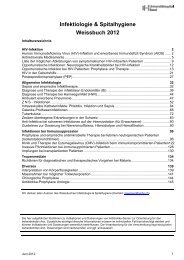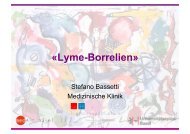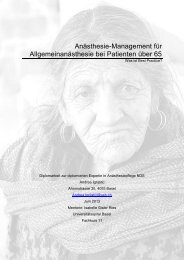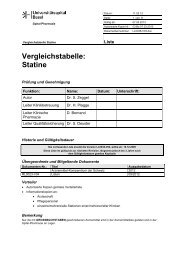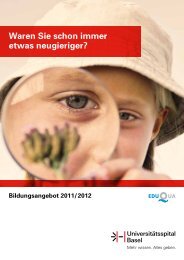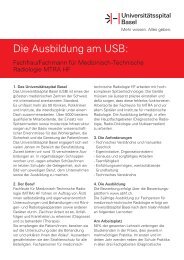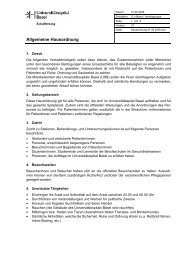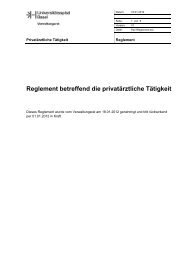Transmucosal Nasal Drug Delivery: Systemic Bioavailability of ...
Transmucosal Nasal Drug Delivery: Systemic Bioavailability of ...
Transmucosal Nasal Drug Delivery: Systemic Bioavailability of ...
Create successful ePaper yourself
Turn your PDF publications into a flip-book with our unique Google optimized e-Paper software.
7. Project III: <strong>Transmucosal</strong> nasal delivery <strong>of</strong> low-dose midazolam – evaluation <strong>of</strong> two preparations for procedural anxiolysis<br />
most likely to experience claustrophobic fear or panic during MRI examinations. But this reduced<br />
questionnaire has not been validated yet and therefore reliability is still unsettled.<br />
Because day’s schedule in radiologic departments is tight, the accomplishment <strong>of</strong> a clinical trial<br />
should not affect work flow. Therefore, to successfully run a clinical trial in clinical everyday life it is<br />
crucial to deliver well structured self-explanatory study material. The documentation should be as<br />
less time-consuming as possible.<br />
Schweizer et al. demonstrated in a pilot study the anxiolytic effect <strong>of</strong> low-dose midazolam (0.5-<br />
1 mg) in prevention <strong>of</strong> panic reactions [Schweizer, et al. 1992]. In addition, nasal delivery <strong>of</strong> lowdose<br />
midazolam proved to be efficient and safe for conscious sedation during MRI examinations<br />
[Tschirch, et al. 2006]. <strong>Nasal</strong>ly administered doses <strong>of</strong> 1 mg to 2 mg midazolam provided anxiolysis<br />
without sedation (i.e., conscious sedation) and therefore the patients were able to follow the<br />
instructions given during MRI examinations. Based on these findings for the present study the dose<br />
<strong>of</strong> 1 mg nasal midazolam (initial dose) was set with the possibility <strong>of</strong> delivering another 1 mg nasal<br />
midazolam if anxiolysis was not provided.<br />
The composition and the multidose delivery device <strong>of</strong> the test preparation<br />
(Midazolam MD <strong>Nasal</strong> Spray 5 mg/ml) refer to the commonly used midazolam nasal spray,<br />
prepared by the local hospital pharmacies. Complying with monograph for nasal preparations <strong>of</strong><br />
Ph.Eur., this aqueous nasal preparation, supplied in multidose delivery systems, is preserved. The<br />
multidose nasal spray used in this trial, delivers 0.1 ml per pump. But for correct dosing at least<br />
1 ml preparation has to be filled into the delivery device. As for the administration <strong>of</strong> 1 mg to 2 mg<br />
midazolam only 0.2 ml to 0.4 ml are delivered, the major portion <strong>of</strong> the preparation is wasted.<br />
Furthermore, to get the multidose nasal spray ready for exact dosing, the pump needs to be<br />
prepared by pressing the pump several times previous to nasal administration. Preparing the pump<br />
inhalation <strong>of</strong> the atomized midazolam preparation is to be prevented. Since the upright position <strong>of</strong><br />
the multidose nasal spay is essential for exact dosing, administration to lying patients is not<br />
possible. As used multidose nasal sprays do not look different from unused multidose nasal sprays,<br />
there is a certain risk for unhygienic multiple application to different patients.<br />
The comparator (Midazolam UD <strong>Nasal</strong> Spray 1 mg) is supplied in a single-dose delivery device and<br />
is preservative-free. The dose <strong>of</strong> 1 mg midazolam is delivered within 0.1 ml by one-sided<br />
administration. For the administration <strong>of</strong> an additional dose, 0.1 ml is sprayed into the opposite<br />
nostril by applying a second unit dose nasal spray. The unit dose nasal spray system contains<br />
0.125 ml nasal preparation, there<strong>of</strong> 0.1 ml is delivered independent <strong>of</strong> the position. Therefore, the<br />
unit dose system allows nasal administration <strong>of</strong> the anxiolytic treatment directly to patients lying on<br />
MRI table, ready to be introduced into the MRI tunnel. As <strong>of</strong>ten patients declare their anxiety only at<br />
the moment they are introduced into the MRI tunnel, administration independent <strong>of</strong> position is<br />
advantageous.<br />
Many patients presenting to radiologists for MRI examination admit anxiety and/or claustrophobia,<br />
but only few <strong>of</strong> them are willing to participate in a clinical trial. Finally, 110 patients gave consent to<br />
enter the trial with nasal midazolam. One patient dropped out because <strong>of</strong> withdrawal <strong>of</strong> consent.<br />
Katja Suter-Zimmermann Page 93 <strong>of</strong> 188 University <strong>of</strong> Basel, 2008




